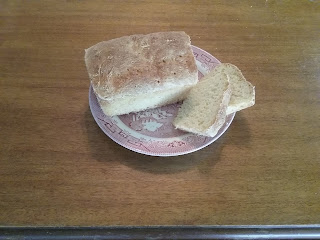The Challenge: Commemorative Dishes. Try preparing something associated with a famous event or person.
The Recipe: Washington Cake from The Prairie Farmer
The Date/Year and Region: 1843, Chicago [possibly reprinted from a Michigan publication if I'm understanding the abbreviations]
How Did You Make It: On a 1/3 scale, still minding those eggs.
I melted 1/3 oz of butter (~2/3 tsp) in 1/3 quart skim milk (~ 10.5 fl oz), added it to 2/3 lb flour (~5 1/3 cup) with 1/3 tsp salt and 1 tsp yeast, and 1 egg. After kneading the dough, it was allowed to rise overnight* (~10 hours) in the pan and then baked for 25 minutes at 350F, and then kept a further 15 minutes in the cooling oven.
*Not the recommended modern food safety practice, what with the dairy and egg. I tried it as an experiment, since no one but me will be eating this loaf.
Time to Complete: About 11 hours, including rising and baking time.
Total Cost: About $1.50 for 1 loaf.
How Successful Was It?: Though called a cake, this is really a bread, albeit one that's light and has a very nice texture. It tastes like white bread-- rich, but fairly bland. Eaten with butter, I think the bread could use a bit more salt. It's fine with jam or with gravy at dinner.
It's nice enough, but not spectacular. I think I prefer the Sally Lunn recipe for making a rich bread that will be eaten promptly, though this might have a place for a fine, rich bread that keeps longer than a few hours (with modern concessions for food safety).
This 1/3 scale recipe perfectly fit a standard (8-1/2" x 4-1/2" x 2-1/2") loaf pan.
How Accurate Is It?: Without context for "1 pennyworth of yeast", I ended up using 1 tsp of dry active yeast, based on modern proportions of yeast to flour for overnight breads. The milk is skim. I used an available pan, though I'm not sure the loaf pan would be the preferred period shape.
 |
| Washington Cake is... a nice but boring white bread. |

